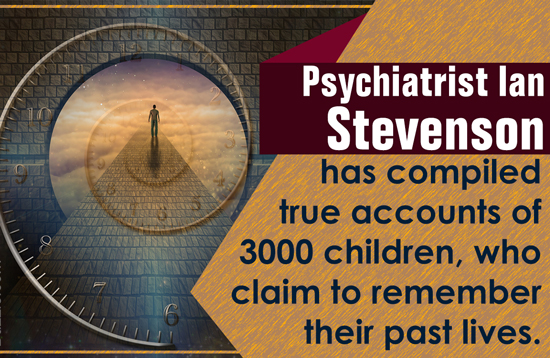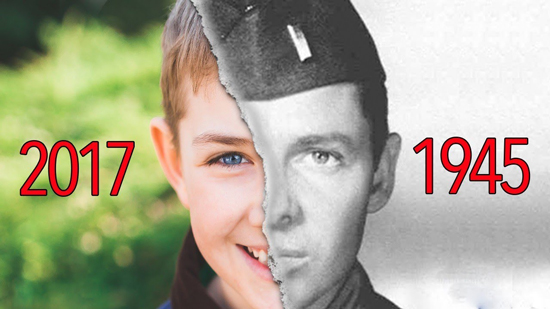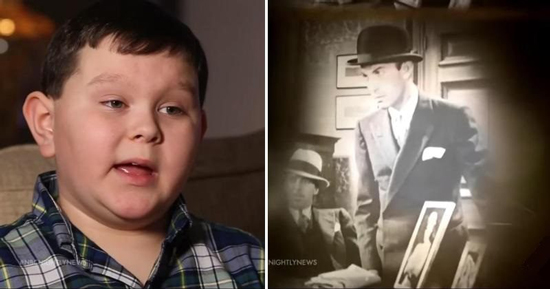Scientific Breakthrough Offers Proof That Reincarnation Exists (3)
Read the second part of the article

Omni:
Do you have a research staff?
Stevenson: Yes, we have two full-time assistants. So far most overseas cases have been investigated first by people on the spot. Obviously they have the immediate advantage over me in that they need no interpreters. On the other hand, not many Asians have been trained in science. Those who are trained have usually come to think of reincarnation as a superstition of their childhoods and one they’d rather forget. But a few Asian scientists have been extremely helpful. In contrast, I remember a Harvard-trained psychologist in Burma who could barely be polite to me. There he was, sitting up in Mandalay, surrounded by cases, and he had no interest in them.
Omni:
What’s next for you?
Stevenson: I’m mainly working now [at the time of this interview] on a massive study of birthmarks and birth defects. I published a few of them in Twenty Cases Suggestive of Reincarnation without much special mention or photographs. I now have about two hundred cases. I hope the first volume of thirty will be published this year. This first group contains cases from India, Burma, Turkey, Lebanon, and northwest North America. They’ll all have photographs, and I’ve been able to match up about fifteen of them with postmortem reports. It’s my most important book, and I’ve been writing it for about ten years. [Note: Stevenson’s truly massive study, Reincarnation and Biology, was finally published in 1997]
Omni:
Do birthmarks occur very often?
Stevenson: Some birthmarks are common. But it depends on what you call a birthmark. The average American has about fifteen. I’m talking about a raised, darkened mole, or what we call an elevated nevus. Some marks are simply areas of increased pigmentation; in other cases, the birthmark is three-dimensional, the area being partly or wholly elevated, depressed, or puckered. I have examined at least two hundred of this kind, and many of them cannot be distinguished, at least by me, from the scars of healed wounds.
In many cases I’ve had to rely on memories of surviving relatives and friends for information about the exact location of wounds or other marks on the previous personality in question. This has led to the sensible objection that relatives might have tailored their memories to fit the circumstances for a variety of reasons. I have been able to overcome this objection in about thirty cases by obtaining autopsy or other medical records. Such records provide the strongest evidence we have so far in favor of reincarnation.
Omni:
You are also interested in the phenomena of precognition and telepathy, aren’t you?
Stevenson: Precognition is just a clearer idea of a possible future. Imagine a person in a canoe paddling down a river. Around the corner are rapids he doesn’t see. Someone on the cliff above, seeing the whole river, can see what’s likely to happen to that person. At any point, of course, the canoeist might pull over to the bank. He doesn’t have to go over the rapids.
What is interesting about precognition, telepathy, or any other form of paranormal communication is the number or people who believe they’ve had at least one experience: between ten and seventeen percent in the United States and Great Britain, according to some surveys. Most can be put down to coincidence, suppressed memories, or any number of plausible explanations. You can discount ninety-five percent of these cases; but for an impressive number there is no natural explanation. Present understanding of our brains leaves no room for these phenomena.
Omni:
What prevented Hamlet from committing suicide was the suspicion that death might not be the end of things. Haven’t you cited cases of children who have committed suicide?
Stevenson: That’s rather rare. We haven’t followed them, of course. Children who remember a previous life that ended in suicide sometimes still have the suicide habit. If things go wrong, they’ll threaten to commit suicide. That we’ve had. We’ve had twenty-three cases involving fear of retribution for suicide in the previous life; and several had phobias about the instrument of suicide – that is, guns in some cases, poison in others. One person told me that her memories of suicide had deterred her from killing herself. The thought that nothing would be over or solved so one might as well face one’s troubles is, in my view, a very effective deterrent.
Omni:
In Memories, Dreams, Reflections, Carl Jung wrote that as a boy he remembered in great detail being a very old man in the eighteenth century.
Stevenson: Children we have studied often act as if they had been transferred without warning from an adult’s body into a baby’s. When one of our Turkish children began to speak, almost the first thing he said was: “What am I doing here? I was at the port”. Later on he described details in the life of a dockworker who had fallen asleep in the hold of a ship. A heavy oil drum had fallen on him and killed him instantly. Cases like this remind me of a woman who had a stroke while playing bridge. When she came around several days later, her first words were: “What’s trumps?”

Omni:
You briefly mentioned your new studies in chronological discrepancies. Are you talking about personalities that are reborn into new children before the end or the previous life?
Stevenson: There are a few of those. In Twenty Cases there’s the case of Jasbir, also a different kind of discrepancy story. He was about two and a half when he appeared to die of smallpox. When he revived he claimed that he was somebody totally different, a man who had just died and stumbled into the body. In his new personality, Jasbir said that after death he had met a mahatma, or a sage, who had told him to take over this body.
There was also a case in Thailand in which a monk, Chaokhun Rajsuthajarn, claimed to have been born a day before the death of Nai Leng, the personality he remembered. These cases are extremely rare in Buddhist countries; Buddhists tend to regard them as suspect and even bogus because they do not harmonize with the Buddhist concept of rebirth. I studied this case with much care but couldn’t find an explanation for the discrepancy.
Omni:
Why do American children have so many less concrete and verifiable memories than Asian children do?
Stevenson: I have speculations and conjectures. First, Americans are nomadic. A fifth of all Americans move from one community to another each year, and a quarter move within the community, changing their neighborhood and environment. Some of the Asian children’s memories are stimulated by their noticing slight environmental differences. If the difference is great, that stimulus may be missing.
Turning the question the other way around, why do certain Asian cultures have so many cases? To begin with, these cultures remember their dead more than we do and see them as still being actively involved in life; they also have stronger family ties. To them there is no such thing as random fate. Everything happens for a reason, and that reason often has to do with someone who wishes them well or ill. They also believe, much more than we do in the West, in telepathy, the paranormal, and that dreams foretell the future. They are not clock-watchers as we are; they have time to reflect on their lives. All these factors may have some bearing on this question and perhaps put them in closer touch with their past lives.
Omni:
When you’re dealing with Asian children, couldn’t you be involved with people whose past lives did not get completed?
Stevenson: That’s right. In dealing with people who died naturally rather than violently, we can distinguish several broad groups. In the first we might place people who were well one moment and dead the next, before they or anyone else had a chance to adjust to the idea. In the second category one might place those who died before the age of twelve of whatever natural causes; in the third there are those who died with unfinished business – mothers who left infants or young children, for instance. One would also have to include people who had not been particularly young when they died but left life in the middle of some absorbing project. Any one of these people might have felt entitled to a longer life than they turned out to have.
Omni:
Is the average space between death of one personality and that personality’s rebirth in a new child about fifteen months?
Stevenson: Yes, but I think our figure comes mainly from Asian cases because, of our roughly one hundred Western cases, only fifteen to twenty have been verified, or, as we say, “solved”. In my paper American Children who Claim to Remember Previous Lives I analyzed seventy-nine cases. They are nowhere near as rich in detail as, say, the Indian cases. American children named few names, for instance, and we could match them up with a deceased person in only sixteen cases; and the person nearly always turned out to be a family member, thus making the case not significant for our purposes. Not a single child claimed to have been famous in a previous lifetime. The majority seemed to be ordinary, undistinguished people, just like the majority of our Asian children.
Omni:
Even so, if the interval is fifteen months for each of us, doesn’t that argue for a staggering number of lives relived?
Stevenson: Well, these cases of children who remember may be exceptional. They may become cases because they do remember, not because they are reborn. How many others may be reborn without remembering, or not reborn? The fifteen month average is perhaps true only for people who are murdered in India.
Omni:
One of your American cases involved a person who remembered a life in which she had been scalped, which would argue for an enormous interval.
Stevenson: Yes, since the eighteenth century in that case. Our analyses have not shown that longer intervals between lives mean fewer memories. We do have to be prepared for the possibility that memories can fade in a world or discarnate minds, just as they can in our own. So we would rarely expect to be able to verify cases in which the interval was greater than twenty-five years. For most people it’s possible the interval between death and rebirth is much longer than the cases we’ve studied so far. With only two thousand cases to go on, I’d hardly dare speculate about the billions of human beings since the beginning of the human race who have disappeared without a trace.

Omni:
Would you speculate on why certain children show up in certain families?
Stevenson: If they are Muslims, they will say God did it. If they’re Hindu or Buddhist, they’ll attribute it to KARMA. It might be that the purpose is to live and learn together. Someone who wants to evolve morally, for instance, should try to be reborn in a saint’s family if he can. The most serious punishment I could imagine for a Mafia murderer would be to be reborn in a Mafia family, with their limited outlook on life. Why a person appears to be reborn in one family rather than another interests me passionately. It’s a question for the next century.
Omni:
Do you have children or your own?
Stevenson: Unfortunately not.
Omni:
Isn’t it often a disadvantage to remember a previous life?
Stevenson: Oh, I think so. These children become embroiled in divided loyalties. In many cases children have rejected their parents, saying they are not their real parents and have often started down the road toward their so-called real homes. In other cases, they insist on being reunited with their former husbands, wives, or children. One Indian boy was passionately attached to the woman he said had been his former mistress and was trying to get her back, causing himself and her real distress.
Omni:
Might someone consider where and how one would like to be reborn?
Stevenson: I think an even more important question is who would want me as a baby?
Omni:
Can I ask where and as whom you would like to be reborn?
Stevenson: No. I think that’s too personal.
Omni:
You must have been somewhat curious about what previous lives you might have led, because you consulted eight sensitives, or mediums.
Stevenson: Consulted is too strong a word. Some gave me these “readings” spontaneously. It just sort of happened along the way. When I was visiting an Indian swami, I didn’t ask him, he just blurted something out. I’ve forgotten what it was. I think he said something about a previous life in India. You could say they were picking up different lives; some had me in different places at the same time. I had two talk about eighteenth-century lives in the same period, and they were completely different. They’re all totally unverifiable. There are people who charge money for this, and it’s a ridiculous waste of everybody’s time.
Omni:
What advice do you have for those who have no memories of a previous life?
Stevenson: Some persons have said it is unfair to be reborn unless you can remember details of a previous life and profitably remember your mistakes. They forget that forgetting is essential to successful living in the present. If every time we walked, we were to remember how we stumbled, we would fall again. I’ve also had people envy children who remember previous lives, as if these children had special wisdom. In fact, it makes more sense to look upon them as suffering from an abnormality, almost a defect. The memories they have are often more of a handicap than a blessing; and they nearly all become happier as they grow older and forget their previous lives. To paraphrase Jesus Christ, sufficient unto one life is the evil thereof.
Omni:
Has your work influenced your own attitudes toward life and death?
Stevenson: I think so. I wouldn’t claim to be free of the fear of death, but it is probably less in me than other people. These children sometimes provide reassurances to adults. We’ve had two or three incidents of children going to, let’s say, a woman who has lost her husband and was inconsolable and saying: “You shouldn’t be crying. Death isn’t the end. Look at me. I died and I’m here again.”
yogaesoteric
July 13, 2018
